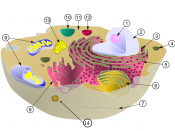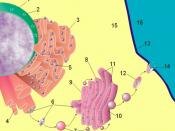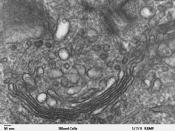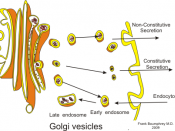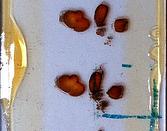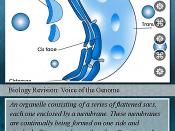The endomembrane system is a system of organelles working together for the same goal. This system compartmentalizes the cell restricting certain metabolic reactions to certain areas of the cell. Phospholipids are a vital element of the endomembrane system it is these bilayers that cover structures like the nucleus, vacuoles, the endoplasmic reticulum (ER), vesicles, and the cell itself.
It is because of the unique properties of the phospholipid bilayer that vesicles are able to so easily fuse with the Golgi apparatus and the plasma membrane, If not for these properties the endomembrane system would not function.
The structures (organelles) that make up the endomembrane system are: The nuclear envelope, The rough and smooth ER, the Golgi apparatus and Golgi bodies, lysosomes, various vesicles, and the plasma membrane.
The nuclear envelope (found around the nucleus) is made of a double phospholipid bilayer, it has two double layers of phospholipids and many pores.
The Nuclear envelope separates the contents of the nucleus from the cytoplasm while still allowing the nucleus and the cytoplasm to communicate the nuclear pores allow mRNA and ribosomal subunits out of the nucleus and protiens into the nucleus The outermost membrane is continuous with the rough ER and has ribosomes its function is similar to that of the plasma membrane.
The endoplasmic reticulum extends out form the nuclear envelope it too is made of a phospholipid bilayer. It weaves through the cytoplasm like hollow canals. The rough ER is studded with ribosomes it functions to fold, transport, and wrap proteins in a membranous sac forming a vesicle that can then transport the protein to its destination. The smooth ER is continuos with the rough ER and has no ribosomes it makes lipids and or steroid and vesicles its specific function changes depending on what type of cell it is in.
Vesicles have many different functions and types they participate in exocytosis, pinocytosis, and endocytosis etc. Vesicles are small sacs made of a phospholipid bilayer they transport and store materials in a cell. Vesicles called peroxysomes, which are found in all eukaryotic cells, break down toxic hydrogen peroxide into H20. Vesicles called glyoxysomes, which are found only in plant cells (specifically seeds) break down the cell's stored energy so it can be used by the growing and dividing cell. Specialized vesicles called lysosomes are produced by the Golgi apparatus and contain very acidic digestive enzymes. Lysosomes play an important role in the cell they digest the cells food, recycle old organelles and digest harmful bacteria. White blood cells have many lysosomes. Lysosomes participate in programmed cell death (apoptosis).
The Golgi apparatus and Golgi bodies consist of stacked flattened membranous sacs. One side of the Golgi apparatus faces the ER and the other side faces the plasma membrane.Vesicles moving through the Golgi apparatus are called Golgi bodies. Vesicles that have come from the ER fuse with the Golgi apparatus which modifies, stores "labels and ships" the contents of the vesicle (usually lipids or proteins) Golgi apparatus could be called the shipping department of the cell. Once a vesicle has exited the Golgi apparatus it will contain membrane from both the ER and the Golgi apparatus, the vesicle is then ready to perform its function which could be anything from exocytosis (secretion) to cell digestion (lysosome).
Biology Ninth Edition, Sylivia mader, Mcgraw Hill 2007
